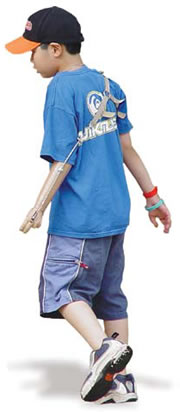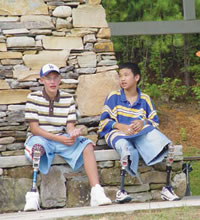Volume 18 · Issue 1 · January/February 2006
by Douglas G. Smith, MD
Limb loss is always devastating, both physically and emotionally. I’ve frequently told patients who have lost a limb or are facing the prospect of losing one, “You are going through something that no one should ever have to go through.”

There are two main categories of limb loss in children: congenital limb deficiency and acquired amputations. A congenital limb deficiency is present at birth. It can involve either the upper or lower limb. Unfortunately, there are also rare instances when multiple limb deficiencies occur. Though congenital deficiencies can be the complete absence of a limb, more commonly, part of the limb is missing and the remaining portion has not formed normally. Sometimes, surgery is performed to straighten the limb or to address limb length inequality. At other times, surgery may be recommended to reshape the limb to enhance prosthetic fit and improve prosthetic use. Surgery is much more commonly recommended for lower-limb congenital deficiencies than for those involving the upper limbs.
In the upper limb, congenital deficiencies most frequently involve the hand. Fortunately, a child can retain quite a bit of function with an upper-limb deficiency, even if a large part of the limb is missing and there are major deformities. It’s rare to perform upper-limb surgery early in the child’s life. It may take time to determine whether the child can effectively grasp and manipulate objects with the involved limb. Rudimentary digits, even if unable to physically grasp objects, may be able to control switches and sensors to enhance prosthetic use. We try to save any parts of the upper limb that may have functionality.
In the lower limbs, minor deficiencies may not need much treatment at all. They may, however, indicate a subtle but more serious involvement of the leg, hip or even the spine. A child with even minor toe or foot deficiencies should have a full orthopedic evaluation of his or her extremities and spine.
Lower-limb congenital deficiencies are evaluated to determine their ability to withstand the forces of weightbearing and walking and to assess the comparative lengths of each leg. Surgery may be necessary to modify the residual limb for a prosthesis so that it will tolerate weightbearing and walking. Congenital deficiencies often lead to complex surgical decision-making, prosthetic fitting, and rehabilitation that are as unique as the deficiencies themselves. Most often, decisions are not rushed into and are made only after much thoughtful discussion, a thorough understanding of all of the issues, and several evaluations to assess the limb’s potential growth and function.
I continue to be amazed by the perseverance, ability and strength of these young individuals and their families. I believe that the noted 17th century French academic Jean De La Bruyere was certainly correct when he stated, “Out of difficulties grow miracles.”
Congenital Limb Deficiencies
Preventing birth defects has been the mission of the March of Dimes since its inception in 1938. President Franklin Roosevelt, himself a polio victim, founded the National Foundation for Infantile Paralysis in 1938 to find a cure for this deadly disease. Later that year, a radio announcer urged listeners to send dimes to the White House to pay for research to find a cure for polio. This was the beginning of the March of Dimes. Here, in the 21st century, its Web site, http://www.marchofdimes.com, provides valuable information on pregnancy, babies, folic acid, premature births, birth defects, and other issues pertaining to children and their families. In addition, data collected by the March of Dimes helps us put congenital limb deficiencies in perspective.

Specific birth defects involving the arms or legs are called congenital limb deficiencies. The overall rate of congenital limb deficiencies is 0.3 to 1 per 1,000 live births in the United States – affecting an estimated 1,500 to 4,500 children per year. Researchers say 58.5 percent of all limb deficiencies in newborns involve the upper limb. Less than half involve the lower limb. A much smaller percentage of these children have involvement of upper and lower limbs. Like the causes of all birth defects, the specific causes of congenital limb deficiencies are frequently unknown.
Genetic factors are sometimes involved. Each of us has about 25,000 genes, according to the latest research in the ongoing effort to map the human genome. An abnormality in just one gene can cause birth defects. Other birth defects appear to be caused by both genetic and environmental factors. Environmental factors might include drug or alcohol abuse during pregnancy, infections, and exposure to certain medications or chemicals. When birth defects are linked to both genetic and environmental factors, we call it multifactorial inheritance. Examples of these types of birth defects are a cleft lip or palate, equinovarus (commonly known as clubfoot), and some heart defects.
While some limb deficiencies do have a genetic factor, it is not always easy to figure out where the abnormal gene came from. We generally think of genetic traits as always being passed down from the mother and father, but with limb deficiencies this often is not the case. Sometimes, genetic problems happen spontaneously. This is called a point mutation, when an abnormal gene occurs uniquely in the embryo. Neither parent has the genetic abnormality; literally, it just happens.
Once a person has such a genetic abnormality, even if it occurs spontaneously and has never occurred before in either side of the family, it is now in that person’s DNA. Some genetic abnormalities can be passed on to future generations, but it’s important to note that others are not. While the defect may be in a person’s DNA, it does not automatically mean that a limb deficiency will be passed on to future generations. Counseling with a geneticist can help determine if a risk is present.
Scientists believe that in most cases no outside agent is to blame and the cause of the genetic mutation simply isn’t known. Limb development begins in the fourth week of gestation and is nearly complete by the eighth week. If an outside agent, such as a hazardous chemical or medication, is involved in transforming a specific gene or affecting limb development, exposure would occur within four to six weeks after conception, a time when most women are not aware that they’re pregnant.
Several toxins, medications and even vitamins are indeed known to affect limb development. The most notorious is thalidomide, a medication prescribed in the 1950s and early 1960s to help relieve nausea in early pregnancy. This led to a number of children, mostly in Europe, who were born with very short upper limbs, often with the hands attached up near the shoulders. These children frequently had severe deficiencies in their legs as well.
In very high doses, retinoic acid (Vitamin A) may affect limb development. Isotretinoin, which is closely related to Vitamin A, is used by some as a treatment for severe acne. Isotretinoin (sold under several brand names, including Accutane) has been linked to birth defects and is not advised for women who are pregnant or who may become pregnant while taking the medicine. In August, the US Food and Drug Administration (FDA) announced a new national registry with strict guidelines to protect the unborn from side-effects from Accutane and the generic forms of isotretinoin. Under the program, a person must enroll in the national iPLEDGE computerized registry, starting December 31, 2005, to receive Accutane or generic versions of isotretinoin. In addition, doctors must register to continue prescribing these drugs, while pharmacists and wholesalers are required to register to continue shipping supplies.
Under the new FDA rules, all patients seeking a prescription for Accutane or generic isotretinoin must sign a document informing them of the risks. Women of childbearing age also must undergo two tests in a doctor’s office or laboratory to ensure that they aren’t pregnant before the initial prescription and monthly pregnancy tests before each refill. The physician must enter the pregnancy test results into the iPLEDGE system. The patients are then required to buy their pills within seven days of these tests. They also must agree to use two forms of birth control while using Accutane and register in iPLEDGE, in addition to the doctor’s initial registration, to report that they’re doing so. Pharmacists must check the iPLEDGE database before filling a prescription to ensure these patients have followed all the rules. Accutane’s manufacturer, Hoffman-La Roche, and generic manufacturers are to monitor drugstores and wholesalers for compliance and have agreed to cut off supplies to violators.
Amputations Resulting From Traumatic Injuries and Disease
The second main category of limb loss in children is acquired childhood amputations. Acquired amputations can be the result of cancer, trauma or severe infections. There are also unique abnormalities of blood vessels or nerves in children that can result in acquired amputations. One abnormality of the blood vessels is called severe hemangiomas. Another example is an abnormality of the nerves that causes congenital insensitivity to pain. In this condition, a child does not have feeling in his or her feet and an amputation may be required after repeated trauma, ulcers and infections. While these are congenital problems, the amputations are considered acquired because they happen later in life and result from complications of the disease.

Injuries are the leading cause of death and disability in children after infancy. Disabling injuries resulting from lawn mowers, traffic accidents, fireworks, power tools, farm equipment, gunshot wounds, or axes or hatchets can require amputation. Less common, but not unheard of, are trauma injuries involving train accidents, horseback riding, ropes or netting, chains, sharp metal, doors, vehicle fan belts, glass, meat slicers and escalators that result in amputation.
It’s difficult to find any national figures for the number of childhood amputations resulting from trauma that occur each year, but looking at regional findings provides some insights. I took part in a study of 74 children admitted to a Seattle trauma center over a 10-year period for amputation or salvage injuries. Boys sustain these injuries much more often than girls – 70 percent vs. 30 percent – and, surprisingly, one-third of all of these injuries occurred to children under the age of 5. The two main causes of amputation in children were lawn mowers and crush injuries.
While the causes of the injuries in our study varied, certain findings were striking. Lawn mowers were the single most common cause of injuries and accounted for nearly half of the injuries to young children. Those under age 5 sustained nearly one-third (32 percent) of all the injuries in this research study, with more than half (57 percent) resulting in amputation. Nearly half (46 percent) of these injuries were due to lawn mower accidents.
Researchers in Minnesota had some similar findings. There were 256 amputations in 235 children at a Minneapolis hospital between 1980 and 2000. Traumatic amputation was caused by lawn mowers in most (69) of those cases, followed by farm machinery (57), motor vehicle accidents (38), trains (20), and miscellaneous mechanisms (51). Fifty-four of the children with lawn mower amputations – 78 percent – were age 5 or under. Most of the amputations (165) involved the lower extremity.
The circumstances involving lawn mower injuries are frequently misunderstood. The majority of lawn mower injuries I see in the Pacific Northwest involve riding lawn mowers. Frequently, a child, who is sitting on the lap of mom, dad or a grandparent, falls off and the blade strikes an arm or leg. Many adults think that it will be fun for the child to ride on their lap while they’re mowing the lawn and they don’t realize the danger. After an accident occurs, they’re devastated. At other times, the child is playing in the yard while the riding mower is in operation and the child runs up behind or in front of it and gets hit. The operator often can’t hear the child over the noise of the mower. The safest thing is to never have a child ride in your lap while you are mowing the lawn and to never allow children to play in the yard while you’re mowing. I believe that these injuries are preventable.
Pediatric limb deficiencies and amputation affect us all profoundly. We wonder how God could allow this to happen to a child. I do not believe that we will ever be able to understand the reasons why, but I am continually amazed by the resilience and determination of all who are touched by these courageous young individuals.
“Never does a man know the force that is in him till some mighty affection or grief has humanized the soul.”
– Frederick W. Robertson
Acknowledgement
Portions of this column were edited from the Atlas of Amputations and Limb Deficiencies, edited by Douglas G. Smith, MD, John W. Michael, MEd, CPO, and John H. Bowker, MD (Chapter 61 by John R. Fisk, MD, and Douglas G. Smith, MD, Chapter 63 by Joan E. Edelstein, MA, PT, and Chapter 64 by Donald R. Cummings, CP, LP).
References
The Journal of Trauma, “Pediatric amputation injuries: etiology, cost and outcome,” by Trautwein LC, Smith DG, Rivara FP. 1996; 41:831-838.
The American Journal of Bone and Joint Surgery, “Demographics of traumatic amputations in children. Implications for prevention strategies,” by R. Loder. 2004 May; 86-A(5): 923-8.
Part 2 and Part 3 of this series will appear in the March/April and May/June issues of inMotion.


